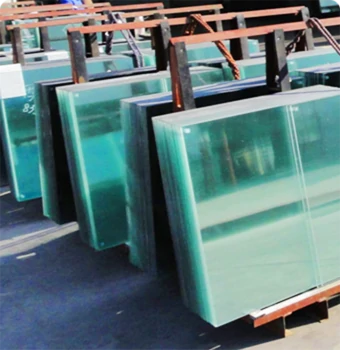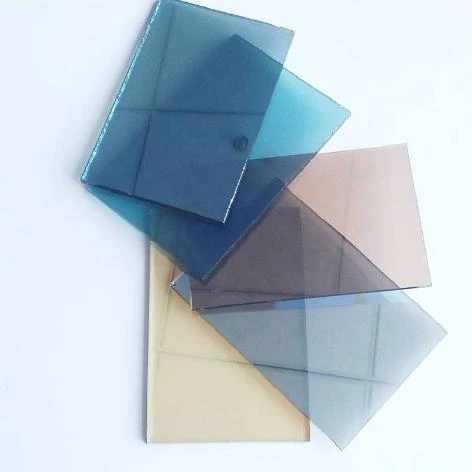Float glass, a term frequently encountered within the architectural and construction sectors, represents a groundbreaking innovation that has redefined how modern structures integrate transparency and style. The float glass manufacturing process is not only an engineering marvel but also a testament to human ingenuity, involving the meticulous transformation of raw materials into a seamless, high-quality product.

The origins of float glass can be traced back to the mid-20th century, revolutionizing glass production by introducing a process that reduced imperfections and enhanced clarity. This method involves molten glass being poured onto a bed of molten tin, where it spreads out to form a uniform layer. The float process allows for precise control over the glass's thickness and surface quality, resulting in sheets of glass that are remarkably smooth and optically clear.
Float glass has widespread applications, owing to its unparalleled qualities. It serves as the fundamental material for windows, facades, mirrors, and even solar panels. Architects and designers favor float glass for its versatility and aesthetic appeal. Contemporary buildings often utilize large panes of float glass to create bright, open spaces while maintaining structural integrity and energy efficiency.

From a technical perspective, float glass properties such as its thermal insulation, soundproofing capabilities, and durability make it a preferred choice for sustainable building practices. Its ability to be tempered or laminated further enhances its safety and performance, making it suitable for environments that demand high resilience.
float glass meaning
Many companies globally, leverage float glass technology to produce specialized products tailored to unique environmental and design challenges. For instance, low-emissivity (Low-E) float glass is engineered to minimize UV and infrared light penetration, optimizing energy usage while maintaining visibility and comfort within the building spaces. Such innovations underscore the commitment to addressing environmental concerns through efficient material usage.
Despite its extensive benefits, working with float glass does require expertise to ensure optimal results. Professionals in the field should be well-versed in handling, installation, and maintenance procedures to preserve the glass's integrity and functionality. Regular inspection and cleaning with appropriate, non-abrasive materials are recommended to retain the glass's clarity and prevent damage.
Float glass represents more than just a construction material; it embodies the principles of modern design and engineering efficiency. Its continued evolution is driven by ongoing research and development efforts aimed at enhancing performance while reducing environmental impact. Organizations and professionals committed to excellence in architecture and construction recognize the value of investing in high-quality float glass products, aligning with both industry trends and consumer preferences.
Understanding the significance of float glass and its applications offers a profound appreciation for this material's role in shaping contemporary architecture. As advancements in manufacturing continue, float glass is poised to contribute significantly to the future of sustainable building practices, supporting a world that seamlessly integrates functionality with aesthetic appeal.
 Afrikaans
Afrikaans  Albanian
Albanian  Amharic
Amharic  Arabic
Arabic  Armenian
Armenian  Azerbaijani
Azerbaijani  Basque
Basque  Belarusian
Belarusian  Bengali
Bengali  Bosnian
Bosnian  Bulgarian
Bulgarian  Catalan
Catalan  Cebuano
Cebuano  Corsican
Corsican  Croatian
Croatian  Czech
Czech  Danish
Danish  Dutch
Dutch  English
English  Esperanto
Esperanto  Estonian
Estonian  Finnish
Finnish  French
French  Frisian
Frisian  Galician
Galician  Georgian
Georgian  German
German  Greek
Greek  Gujarati
Gujarati  Haitian Creole
Haitian Creole  hausa
hausa  hawaiian
hawaiian  Hebrew
Hebrew  Hindi
Hindi  Miao
Miao  Hungarian
Hungarian  Icelandic
Icelandic  igbo
igbo  Indonesian
Indonesian  irish
irish  Italian
Italian  Japanese
Japanese  Javanese
Javanese  Kannada
Kannada  kazakh
kazakh  Khmer
Khmer  Rwandese
Rwandese  Korean
Korean  Kurdish
Kurdish  Kyrgyz
Kyrgyz  Lao
Lao  Latin
Latin  Latvian
Latvian  Lithuanian
Lithuanian  Luxembourgish
Luxembourgish  Macedonian
Macedonian  Malgashi
Malgashi  Malay
Malay  Malayalam
Malayalam  Maltese
Maltese  Maori
Maori  Marathi
Marathi  Mongolian
Mongolian  Myanmar
Myanmar  Nepali
Nepali  Norwegian
Norwegian  Norwegian
Norwegian  Occitan
Occitan  Pashto
Pashto  Persian
Persian  Polish
Polish  Portuguese
Portuguese  Punjabi
Punjabi  Romanian
Romanian  Russian
Russian  Samoan
Samoan  Scottish Gaelic
Scottish Gaelic  Serbian
Serbian  Sesotho
Sesotho  Shona
Shona  Sindhi
Sindhi  Sinhala
Sinhala  Slovak
Slovak  Slovenian
Slovenian  Somali
Somali  Spanish
Spanish  Sundanese
Sundanese  Swahili
Swahili  Swedish
Swedish  Tagalog
Tagalog  Tajik
Tajik  Tamil
Tamil  Tatar
Tatar  Telugu
Telugu  Thai
Thai  Turkish
Turkish  Turkmen
Turkmen  Ukrainian
Ukrainian  Urdu
Urdu  Uighur
Uighur  Uzbek
Uzbek  Vietnamese
Vietnamese  Welsh
Welsh  Bantu
Bantu  Yiddish
Yiddish  Yoruba
Yoruba  Zulu
Zulu 


